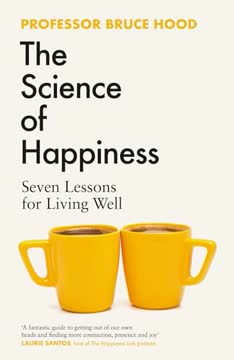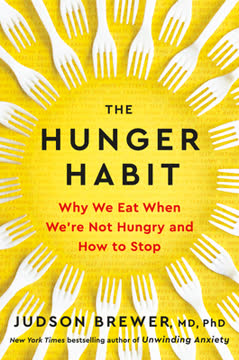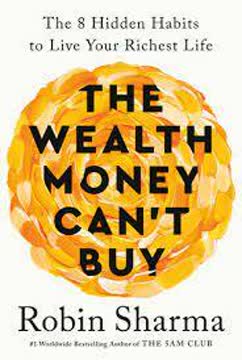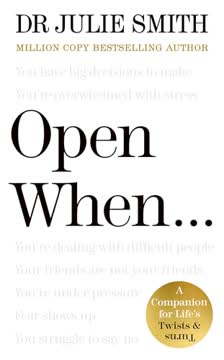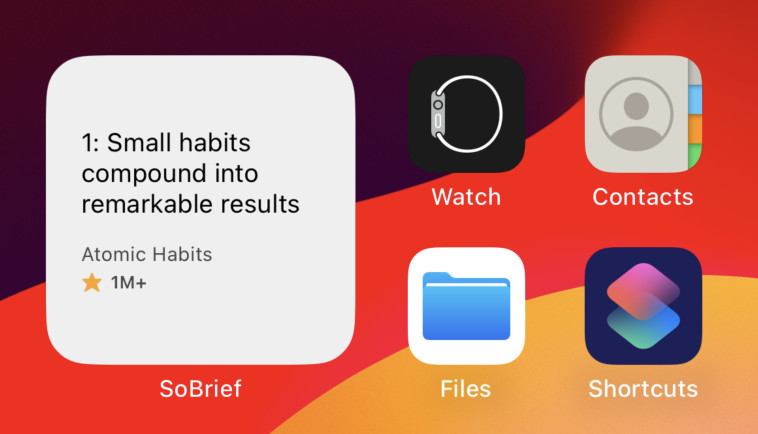Key Takeaways
1. Happiness is a Skill: Cultivate an Allocentric Mindset
Making you happier is the purpose of this book.
Happiness is learnable. While young children often exhibit natural joy, many adults become dissatisfied. The author, initially skeptical of positive psychology, found that teaching a "Science of Happiness" course led to a significant 10-15% increase in student well-being. This demonstrates that happiness is not merely a fleeting emotion but a skill that can be learned and improved through evidence-based practices, much like physical health requires consistent effort.
Shift your perspective. Our default "egocentric" view places ourselves at the center, magnifying problems and making relationships one-sided. This self-focus often leads to unhappiness. In contrast, an "allocentric" view reduces the self, fosters reciprocal relationships, and puts problems into perspective. This shift is crucial because our social interactions as children lay the foundation for adult happiness, and getting along with others requires moving beyond self-centeredness.
The self is constructed. Our "self" is a dynamic construct, a combination of conscious awareness (I-self) and accumulated memories (Me-self). This means our identity is not fixed but constantly rewritten by experiences. Recognizing this "illusion" of a static self allows us to detach from negative self-perceptions and actively reshape our ego. By understanding that our self is interconnected with others, we can liberate ourselves from self-imposed burdens and foster greater happiness.
2. Social Connection is Your Lifeline to Well-being
The most consistent predictor of happiness was good social relationships.
Evolutionary imperative. Humans evolved with proportionally large brains and long childhoods, making us uniquely dependent on social groups for survival. Difficult childbirth, requiring assistance, fostered early cooperation. This deep-seated need for connection means our happiness is intrinsically linked to others, as evidenced by the Harvard Study of Adult Development, which found good social relationships to be the strongest predictor of well-being over eighty years.
Isolation's severe cost. Social isolation, ostracism, and rejection are profoundly painful, activating the same brain regions as physical pain. This "social death" can lead to helplessness, depression, and even premature death, posing a greater health risk than obesity or smoking. Chronic stress, exacerbated by isolation, deregulates the body's stress response (HPA axis), impairing the immune system and shortening lifespan.
Prosociality boosts joy. Engaging in acts of kindness, even anonymously, triggers a "warm glow" in the brain's reward centers, linking generosity directly to happiness. This "impure altruism" benefits both giver and receiver, fostering a positive feedback loop. While social media offers connection, it often fuels negative social comparison and unrealistic portrayals, paradoxically increasing feelings of inadequacy and loneliness, especially among vulnerable adolescents.
3. Beware the Comparing Brain: Your Happiness is Relative
When less is more: counterfactual thinking and satisfaction among Olympic medalists.
Perception is relative. Our brains are wired to make constant comparisons, influencing how we perceive everything from object size (Ebbinghaus illusion) to our own happiness. This means our judgment of well-being is subjective and heavily dependent on who or what we compare ourselves to. For instance, silver medalists are often less happy than bronze medalists because they compare themselves to gold winners ("what could have been"), while bronze winners compare downwards to those who didn't medal.
Mindbugs distort reality. We use mental shortcuts, or heuristics, that can lead to faulty judgments.
- Availability bias: Overestimating rare, dramatic events (shark attacks) because they come to mind easily.
- Anchoring: Basing estimates on initial, often irrelevant, information (e.g., believing our social life is worse than others' by comparing to "party animals").
- Focalism: Overestimating the impact of a single event on future happiness, ignoring other life factors (e.g., lottery wins or paralysis).
Combat the treadmill. The "hedonic treadmill" describes our tendency to quickly adapt to positive changes, returning to a baseline level of happiness. This means material wealth or major life events often don't provide sustained joy as predicted. To counteract this, practice gratitude, which forces downward comparisons and appreciation for what you have, and savor positive experiences by focusing attention on their details to amplify pleasure.
4. Train Your Mind for Optimism, Not Just Survival
Optimism is associated with exceptional longevity in 2 epidemiologic cohorts of men and women.
Wired for negativity. Humans evolved with a "negativity bias," making us faster to detect and remember negative signals (e.g., angry faces, threatening sounds). This was adaptive for survival in dangerous environments. However, in modern society, this bias often leads to chronic anxiety and overreaction to non-life-threatening challenges like job interviews or public speaking.
Optimism is a choice. While we may be pessimistic about the world, we tend to be optimistic about our personal futures. Optimism and pessimism are distinct traits, and optimism can be learned. Optimists attribute setbacks as:
- Less pervasive: Not generalizing failure to all aspects of life.
- Temporary: Viewing problems as transient hiccups.
- External: Attributing blame to external circumstances, not personal fault.
This "attributional style" is key to resilience.
Cultivate positive thinking. Use the ABCDE technique (Adversity, Belief, Consequence, Dispute, Energize) to challenge negative thoughts and reframe setbacks. Dispute beliefs by finding alternative interpretations and energize yourself with a positive outlook. Optimists are healthier, live longer, and have stronger social support because they persist in overcoming stressors and adopt healthier lifestyles. Balance this with "mental contrasting" (WOOP: Wish, Outcome, Obstacles, Plan) to combine positive visualization with pragmatic planning, ensuring goals are not just wished for but actively pursued.
5. Master Your Attention to Quiet the Wandering Mind
A wandering mind is an unhappy mind.
The restless mind. Our minds spend nearly half the waking day "mind-wandering," often drifting to negative thoughts and worries, especially when not focused on a task. This internal preoccupation, or "rumination," is linked to unhappiness and is driven by the Default Mode Network (DMN) in the brain, which is overactive in depression and social isolation.
Nature's calming effect. Spending time in nature significantly reduces stress by deactivating the amygdala (fear center) and dampening the DMN, leading to less mind-wandering. Just two hours a week in natural spaces can improve health and well-being. This "biophilia" reflects our evolutionary affinity for natural environments, which restore our ability to focus and recover from stress.
Control your focus. Attention acts like a spotlight; we can only focus on a finite amount of information. Trying to suppress unwanted thoughts often backfires, leading to "ironic thought suppression" (e.g., the white polar bear effect), where the thought becomes more prominent. Mindfulness meditation helps by gently redirecting attention to the present moment (e.g., breath, senses), preventing intrusive thoughts from hijacking the mind and reducing DMN activity.
6. Forge Deeper Connections Through Synchrony and Compassion
Compassion is feeling for and not feeling with the other.
Synchrony amplifies joy. Shared experiences, especially synchronized activities like dancing, singing, or drumming, amplify pleasure and foster social cohesion. This "good vibration" not only feels good due to endorphin release but also blurs the boundaries between self and others, shifting us towards an allocentric perspective. Even brain activity can synchronize between individuals during shared understanding, highlighting the deep connection forged through mutual engagement.
Cultivate compassion. While empathy involves "feeling with" another's suffering, it can lead to empathic distress and burnout. Compassion, however, is "feeling for" others—characterized by warmth, concern, and a motivation to help, without sharing their suffering. Compassion training, like "loving-kindness meditation," can be learned, promoting prosocial behavior, individual happiness, and resilience by extending positive feelings from oneself to an ever-widening circle of others.
Openness broadens life. Psychologist Barbara Fredrickson's "broaden and build" theory suggests that positive emotions broaden our attention, thoughts, and behaviors, making us more open to new ideas and social interactions. This contrasts with negative emotions, which narrow our focus. Cultural factors, like historical farming practices (e.g., cooperative rice farming vs. individualistic wheat farming), can also shape a society's collective or individualistic mindset, influencing openness and trust.
7. Transcending the Ego: Find Awe and Purpose Beyond Yourself
The happiness of your life depends on the quality of your thoughts.
Beyond the self. While egocentrism is a default, we can actively alter our ego to find deeper happiness. Psychedelic experiences, rituals, and ceremonies can induce temporary "ego-dissolution," fostering a profound sense of connectedness to the cosmos and a new perspective on reality. These experiences, when managed, can be therapeutic for conditions like depression by impacting the brain's self-referential networks.
Embrace awe and curiosity. Experiencing "awe"—whether from vast landscapes, profound art, or the night sky—makes us feel small and insignificant, shifting focus away from personal problems and fostering a sense of connection to something larger. To combat adaptation, actively seek new awe-inspiring experiences and rekindle childlike curiosity by asking "why" questions about the world around you, deepening your understanding and appreciation.
Selflessness for lasting joy. While self-centered pursuits offer fluctuating, transient happiness (due to adaptation and external dependency), selfless acts directed towards others promote more enduring, authentic happiness. When we act for the group, the joy is distributed and perceived as more sustained, as we are not solely privy to its cessation. The ultimate balance lies in making others happy, which in turn enriches both your life and theirs, leading to a more stable and profound sense of well-being.
Last updated:
FAQ
What is The Science of Happiness: Seven Lessons for Living Well by Bruce Hood about?
- Science-based happiness guide: The book explores how happiness can be understood and improved using scientific evidence from psychology, neuroscience, and evolutionary biology.
- Seven lessons framework: It is structured around seven key lessons that teach readers how to live well by shifting perspectives and adopting healthier habits.
- Focus on self and connection: Central themes include balancing egocentric (self-focused) and allocentric (other-focused) perspectives, and the importance of social connection for well-being.
- Practical and theoretical blend: The book combines practical exercises with explanations of the underlying science, making it both actionable and insightful.
Why should I read The Science of Happiness by Bruce Hood?
- Evidence-based insights: The advice and techniques are grounded in rigorous scientific research, including brain imaging and psychological studies, making them trustworthy.
- Addresses modern challenges: The book tackles contemporary issues like social media, loneliness, and stress, offering relevant solutions for today’s world.
- Practical and accessible: Complex concepts are broken down into actionable lessons, with exercises that can be easily applied to daily life.
- Deeper understanding: Readers gain not just tips, but also an understanding of why these methods work, enhancing motivation and effectiveness.
What are the key takeaways from The Science of Happiness by Bruce Hood?
- Alter your ego: Shifting from an egocentric to an allocentric perspective is crucial for reducing negative rumination and increasing happiness.
- Social connection is vital: Building and maintaining strong relationships is essential for emotional and physical well-being.
- Manage mindbugs and biases: Awareness of cognitive biases like negativity bias and social comparison helps prevent distorted happiness judgments.
- Optimism and attention control: Cultivating optimism and learning to manage attention (e.g., through mindfulness) are key strategies for well-being.
What are the seven lessons for living well in The Science of Happiness by Bruce Hood?
- Alter your ego: Recognize the self as an illusion and reduce egocentric thinking to avoid negative rumination.
- Avoid isolation: Foster social connections and community to protect against loneliness and its health risks.
- Reject negative comparisons: Understand and manage the brain’s tendency for social comparison and negativity bias.
- Become more optimistic: Use techniques like learned optimism and mental contrasting to build a positive outlook.
- Control your attention: Practice mindfulness and psychological distancing to reduce mind-wandering and negative self-focus.
- Connect with others: Engage in synchrony, active listening, and compassion training to strengthen social bonds.
- Get out of your own head: Seek experiences of awe, flow, and even psychedelics (where appropriate) to dissolve the ego and foster connectedness.
How does Bruce Hood define and explain the self and egocentrism in The Science of Happiness?
- Self as a construct: The self is described as an illusion, a mental model created by conscious awareness and autobiographical memory.
- Egocentrism’s downside: Excessive self-focus leads to rumination, worry, and negative biases, which undermine happiness.
- Developmental perspective: Children start out egocentric and gradually develop the ability to take others’ perspectives, highlighting the importance of shifting toward allocentrism.
- Balance is key: True happiness comes from balancing self-identity with an outward, allocentric focus.
What are "mindbugs" in The Science of Happiness by Bruce Hood, and how do they affect happiness?
- Definition of mindbugs: Mindbugs are cognitive biases and heuristics that evolved to process information efficiently but often lead to systematic errors in judgment.
- Examples and effects: Biases like negativity bias, availability bias, and adaptation distort how we perceive ourselves and our circumstances, often undermining happiness.
- Impact on well-being: These biases cause unfair comparisons, overemphasis on negative events, and chasing unattainable goals.
- Counteracting mindbugs: Practices such as gratitude journaling, savoring positive moments, and reframing failures help mitigate their negative effects.
How does The Science of Happiness by Bruce Hood address the role of social connection in happiness?
- Evolutionary necessity: Humans are wired for social connection, with large brains and long childhoods requiring cooperative bonds for survival.
- Attachment and health: Secure attachments in childhood predict adult well-being, while isolation and loneliness increase risks of disease and early death.
- Social activities: Engaging in synchrony (e.g., dancing, singing) and acts of kindness boosts happiness and strengthens social bonds.
- Trust and society: High-trust societies and strong social capital are linked to greater happiness and societal well-being.
What does Bruce Hood say about mind-wandering and its impact on happiness in The Science of Happiness?
- Mind-wandering prevalence: Our minds wander about half the waking day, often drifting to worries about the past or future.
- Negative mood link: Mind-wandering, especially to unpleasant topics, is closely linked to unhappiness and activates the brain’s default mode network (DMN).
- Evolutionary roots: While mind-wandering had survival value, it now often leads to unnecessary rumination and anxiety.
- Managing mind-wandering: Mindfulness meditation, spending time in nature, and psychological distancing are recommended to quiet the DMN and improve mood.
What is psychological distancing, and how does it improve happiness according to The Science of Happiness by Bruce Hood?
- Definition and technique: Psychological distancing involves referring to oneself in the third person or non-first-person terms when reflecting on problems.
- Emotional benefits: This technique reduces the emotional intensity of worries, making problems feel less overwhelming.
- Neuroscientific basis: Brain imaging shows that distancing decreases activity in the medial prefrontal cortex, reducing self-referential thought.
- Practical application: Hood recommends using this method to gain perspective and break negative thought loops.
What practical exercises and methods does Bruce Hood recommend in The Science of Happiness to boost well-being?
- Mindfulness and meditation: Daily mindfulness practice helps control attention and reduce intrusive negative thoughts.
- Gratitude and savoring: Keeping a gratitude journal and focusing on positive experiences counteracts adaptation and negative comparisons.
- Random acts of kindness: Performing spontaneous, anonymous acts of generosity activates the brain’s reward system and increases happiness.
- Box breathing and ABCDE: Techniques like controlled breathing and cognitive reframing (ABCDE, WOOP) help manage stress and setbacks.
- Social connection and nature: Engaging in social activities and spending time in nature are also emphasized for their mood-boosting effects.
How does The Science of Happiness by Bruce Hood discuss optimism and its benefits?
- Attributional styles: Optimists interpret setbacks as temporary and external, while pessimists see them as permanent and personal.
- Learned optimism: Techniques like the ABCDE method and mental contrasting (WOOP) can help cultivate a more optimistic outlook.
- Health and longevity: Optimism is linked to lower stress, better immune function, stronger social networks, and longer life.
- Balanced approach: While optimism is beneficial, it should be balanced with realistic planning to avoid recklessness.
What are the best quotes from The Science of Happiness by Bruce Hood, and what do they mean?
- “My life has been filled with many tragedies, most of which never occurred.” — Mark Twain; highlights how excessive worrying is often about imagined problems, not real ones.
- “The happiness of your life depends on the quality of your thoughts.” — Marcus Aurelius; emphasizes the importance of mental perspective in shaping well-being.
- “A wandering mind is an unhappy mind.” — From Killingsworth and Gilbert’s study; underscores the direct link between mind-wandering and decreased happiness.
- “You’re just a man. You’re just a man.” — Marcus Aurelius’s assistant; illustrates the value of psychological distancing and humility for better mental health.
Review Summary
The Science of Happiness receives mostly positive reviews, with readers praising its scientific approach, engaging writing style, and practical advice. Many find it informative and thought-provoking, appreciating the balance between theory and application. Some reviewers note that the content isn't entirely new but serves as a good introduction to positive psychology. A few critics find it too basic or theoretical. Overall, readers value the book's insights on understanding and improving happiness, with many recommending it as a worthwhile read.
Similar Books
Download PDF
Download EPUB
.epub digital book format is ideal for reading ebooks on phones, tablets, and e-readers.
